
A Guide to the Amphibians
and Reptiles of California

Non-Native Species of Amphibians and Reptiles
That Might Be Established in California
(Also known as introduced species, exotic species, alien species, non-indigenous species, or invasive species (if they have been proven to be harmful.)
 |
| The California Department of Fish & Wildlife has an Invasive Species Program to prevent the spread of invasive species and to reduce their negative effects. You can look through their regulations regarding invasive species here and at Fish and Wildlife Code Section 6400. |
| Report an Invasive Species Sighting to the California Department of Fish and Wildlife |
| Report a Nonindigenous Aquatic Species to the USGS |
| California Department of Fish and Wildlife information about how to prevent introductions of Invasive Species |
| California Department of Fish and Wildlife .pdf About Problem Pets The United States Geological Survey Nonindiginous Aquatic Species website has a database of non-native aquatic species that you can search by state, including California. This excludes non-aquatic species including most lizards and snakes, but you can see several frog and turtle species on the list that have been found in the state that I may not include on my lists. |

| These are species that have been found but are not yet documented by a published paper or note as established in California |
|||||||
| Other lists of non-native species found in California | |||||||
| Species formerly established, apparently no longer present |
Species confirmed as established in California |
Feral non-native pets found in California |
|||||
| Some non-native species of amphibians and reptiles found in the pet trade have become established in California, but others have originated as stow-aways in goods or plants transported from outside the state, and a few were accidentally or intentionally released from laboratories or the food industry, or escaped when used as fish bait. Released, escaped, or transported herps of almost any species are sometimes found in the wild, especially in heavily-populated areas, but these do not necessarily constitute an established population. See our separate page of Feral Pet Herps found in the state. My intent here is to try to keep track of the established non-native species which are the most common and widespread. There are certainly more species which have become established in small areas in California which are not on this list. (House Geckos living in pet stores, for example - it is doubtful these geckos have invaded the rest of the neighborhood so they can't really be considered established yet.) More species will probably become established in the state in the future, and some introduced populations will disappear due to competition, climate, disease, intentional eradication, or due to other causes. Please contact me by email if you find any wild non-native amphibians or reptiles in the state. Send a picture if you can. I will try to contact somebody who is working to document them and to keep them from getting established. |
|||||||
Many non-native amphibians and reptiles have escaped into the wild in California. Alligators and Caiman occasionally show up in lakes and ponds and the press usually makes a big fuss over them. Most urban lakes contain a number of exotic species of turtles. (Jeff Lemm, in his Field Guide to the Amphibians and Reptiles of the San Diego Region, quotes biologist Mark Jennings, who has extensively surveyed California for amphibians and reptiles, as stating that there are "roughly 30 species of exotic turtles found in southern California's waterways, although not all of these are established." There are certainly many more alien species than are covered here that have entered the wild in the state, but these are typically isolated instances and do not necessarily represent breeding populations, so they are not considered to be established non-native or exotic species, and they are not listed here. |
|||||||
The herps found below have been observed in the wild in California but have not yet been put on my state lists of established non-native species because I have not yet learned of any published documentation of their established presence. When I learn of documentation herps on this page will be moved to the established species lists. It could be that I'm just not aware of such documentation, so please contact me if you know of any or if you have any pictures or additional information about any of the species on this page or any other non-native herps in California. |
|||||||
Non-Native Lizards Possibly Established in California, but Not Yet Documented |
|||||||
| Anolis equestris - Knight Anole (Cuban Knight Anole) | |||||||
| There is an internet rumor that populations of these Cuban lizards occur in San Diego County. They have been established in Florida and Hawaii. Wikipedia |
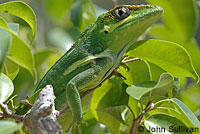 © John Sullivan |
||||||
| Chamaeleo calyptratus - Veiled Chameleon | |||||||
| Four specimens of this species native to the Arabian Peninsula were put in a museum collection in 1999. They are listed as coming from Contra Costa County, apparently at a business owned by a breeder, so they may have been from a population of escaped chameleons. I have also been informed that a population of this species was established on private property in Jamul, San Diego County, in the early 2000s and might still be there. (The lizard in the picture to the right came from that population.) Apparently they originated from the escape of a captive collection. Wikipedia |
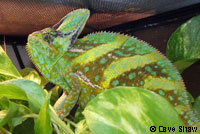 © Dave Shaw |
||||||
| Hemidactylus frenatus - Common House Gecko | |||||||
| Also called: Asian House Gecko. Wikipedia This gecko, originally from Southeast Asia, has been found in Garden Grove in Orange County (Natural History Museum of Los Angeles County specimen 2/14/12) but I am not yet (2/21) aware of any published information reporting that they are established in California. I have also received a personal report of an established population of some species of house gecko in Westchester Los Angeles which might be this species. These observations probably indicate established populations, but I can't be sure of that. There are also some records on iNaturalist from Baja California near the California border. H. frenatus has become established all over the world, including the United States where (so far) it has been found in North Carolina, Arizona, Hawaii, Florida, Georgia, Texas, New Mexico, Oklahoma, Arkansas, Mississippi, Louisiana, and Alabama, Tennessee, and California. (according to Wikipedia on 6/26/17). |
 Dark phase 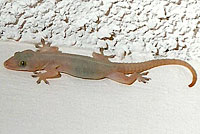 Light phase |
||||||
| Hemidactylus platyurus - Flat-tailed House Gecko | |||||||
| Also known as Asian Flat-tailed House Gecko; Flat-tailed Gecko; Asian House Gecko; Frilled House Gecko. Also known as Cosymbotus platyurus. Originally from Southeastern Asia and Southern Asia. Wikipedia I am unaware of any published documentation of any California breeding populations for this species yet (2/21) so I have not added it to my state list yet, because even though there have been several observations they may not be from established populations. According to Hansen and Shedd (California Amphibians and Reptiles, 2025 p. 144) the species was: "First observed in CA adjacent to a reptile-import business in the late 1980s; that population appears to have died out following a change in the commercial landscaping and sprinkler system." Flat-tailed House Geckos have been recorded from several locations in coastal southern California, including: San Diego County - A breeding population has been reported at the San Diego Zoo in Balboa Park, San Diego County. There are several iNaturalist records for the species there, most around the reptile house, with a photo and a comment from Greg Pauly, Associate Curator of Herpetology at the Natural History Museum of Los Angeles County, who states: "There is a known population of this species established at the Reptile House." There is also a specimen record in the NHMLA from the Reptile House. Orange County - There is a record for one specimen collected in Santa Ana in 2016 in the Natural History of Museum of Los Angeles County. There are also several specimens in the NHMLA collection from Orange County with no specific location given, and a couple of iNaturalist observations from Orange County. Los Angeles County - There are iNaturalist observations from Los Angeles and a specimen in the HNMLA collection with no specific location given. There are several observations listed in the H.E.R.P. database from Orange and San Diego Counties. |
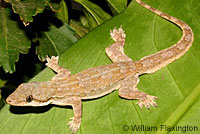 Adult, Orange County Adult, Orange County © William Flaxington |
||||||
| Bearded Dragon - genus Pogona | |||||||
| These common pet lizards show up occasionally just about anywhere after escaping or after their owners dump them when they are no longer wanted. In February 2016 I received a report that there is a feral population of these lizards in Tehachapi and nearby Bear Valley, but I have not seen any published confirmation of this yet. Wikipedia |
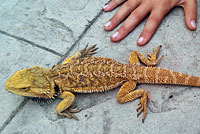 |
||||||
Non-Native Turtles Possibly Established in California, but Not Yet Documented |
|||||||
| Geochelone pardalis - Leopard Tortoise |
|||||||
| A population of breeding Leopard Tortoises has been reported at Mission Trails Park in San Diego County. These tortoises, originally from Africa, are common pets. I have misplaced the source of this report, but Benjamin Lowe wrote in to tell me that "It comes from a list of the park's reptiles and amphibians that once graced the park's website and no longer seems to exist." My search of the park website also failed to find a herp species list, but if they were on the old list, it follows that they were most likely present at one time in the park. Wikipedia |
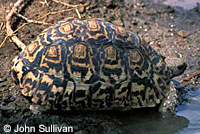 © John Sullivan |
||||||
| Malaclemys terrapin - Diamondback Terrapin | |||||||
| Abandoned pets still show up occasionally in brackish California waters, and it's possible some are reproducing. Diamond-backed Terrapins are found all along the east coast of the United States, living in salt marshes and brackish water. They became famous as one of the best tasting turtles for making turtle soup, and were so abundant and easy to catch that huge numbers were harvested and sold until by the 1900s populations were becoming greatly reduced. They are currently (2020) classified as Near Threatened by the IUCN because its population is decreasing across much of its range, but they are also listed as endangered in Rhode Island and threatened in Massachusetts. (Wikipedia.) Because of their popularity, attempts were made to introduce Diamondback Terrapins into the San Francisco Bay to provide a source of food, but these attempts failed: According to Brown, P. R. (1971). "The story of California diamondbacks". Herpetology. 5: 37–38, in 1896, an unknown person introduced 129 turtles in the San Francisco Bay region. The turtles did not survive. In 1943 the Consolidated Sportsmen's Clubs of the Peninsula provided funding for an attempt to establish Diamondback Terrapins into the San Francisco Bay. Two groups of turtles, raised by the U.S. Fish and Wildlife Service in North Carolina, were planted on a small, unnamed island in the southern S.F. Bay in May, 1943 - 485 yearlings at one spot, and 77 adults (52 females and 25 males) at a second spot. The California Department of Fish and Game then enacted a law that made it unlawful to take Diamondback Terrapins at any time in the state. But even though there appeared to be plentiful food and suitable habitat on the island, a search of the island in October 1943 failed to find any signs of terrapins. The turtles had disappeared and were apparently never established in the bay. Also see: California Fish and Game Vol. 30 No. 2, April 1944, pp. 101-102, "Diamond-back Terrapin Introduced into California." |
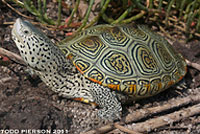 © 2011 Todd Pierson 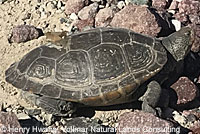 © Henry Hwang, Vollmar Natural © Henry Hwang, Vollmar Natural Lands Consulting |
||||||
| In June, 2020, while doing a survey for pond turtles for Vollmar Natural Lands Consulting in the San Francisco Bay Delta north of Concord, Henry Hwang discovered a gravid Diamondback Terrapin (shown here below and to the right) attempting to dig a nest and lay eggs on the side of a railroad berm near a brackish salt marsh. The turtle was removed before laying her eggs, but this reproductive female could represent a breeding population. There is no way to know for certain until more terrapins are found, because she could have been a pet that was abandoned while gravid. | |||||||
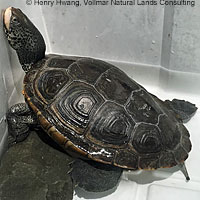 |
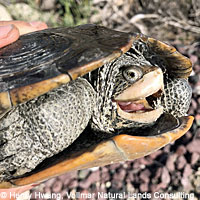 |
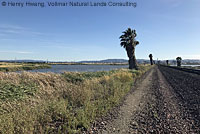 |
|||||
| The four terrapin and terrapin habitat photos above are all © Henry Hwang, Vollmar Natural Lands Consulting. | |||||||
Non-Native Snakes Possibly Established in California, but Not Yet Documented |
|||||||
| Beauty Rat Snake - (Beauty Snake) - Orthriophis taeniurus | |||||||
| More than one specimen of these snakes has shown up in Contra Costa County and in Santa Ana but it is not known if they are breeding in either location. Wikipedia |
|||||||
 © Gailene Nelson |
|||||||
| Non-Native Crocodilians Possibly Established in California, but Not Yet Documented | |||||||
| American Alligator - Alligator mississipiensis | |||||||
| No established populations of alligators, crocodiles, or caiman have ever been found in California as far as I am aware, but every once in a while the press goes crazy about a feral pet alligator that was found in a pond or lake in California. A good example is "Reggie," an alligator that inhabited Lake Machado in Los Angeles County (Wikipedia Article) before it was captured and brought to the Los Angeles Zoo in 2007. Recently I was made aware that it's possible that more than one Alligator has been found in the Prado Flood Control Basin in Riverside and Orange Counties. The species is listed in a 2006 study of aquatic predators in the Prado Wetlands as having been found there, and I am told that the skin of a large alligator that was killed there is mounted in the Duck Club office at Raahauge’s Shooting Enterprises in Norco. It's also possible that the alligator on display was the only one found there and it is the only reason for the species being listed in the report. (Let me know if you know any more details about alligators at the Prado Wetlands.) The USGS Nonindigenous Aquatic Species database also shows several more locations where alligators have been found in the wild in California, including locations near Chico, San Andreas, Oakley Clear Lake, Napa, and the Sherman Island area in the Sacramento River delta. Wikipedia |
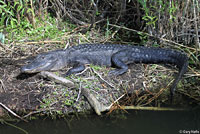 |
||||||
Non-Native Frogs Possibly Established in California, but Not Yet Documented |
|||||||
| Osteopilus septentrionalis - Cuban Treefrog | |||||||
| I list this frog here because although they are kept as pets and Cuban Treefrogs found in California might be escaped pets, they have also been found on nursery plants which may have been imported from nurseries in Florida where this frog is an established invasive species. The transportation of Cuban Treefrogs and their eggs on nursery plants is a possible method of introduction of this species into the state, though it is not known if they can survive in the dryer, less humid environment. When I last checked in February 2021 there are were only two iNaturalist records for this species from Newport Beach and San Diego. Previous records from Fresno and Ramona have been removed, so they must have been inaccurate. Wikipedia |
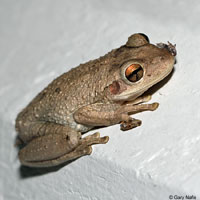 |
||||||
So far there are no non-native species of salamanders found in California that are not yet confirmed as established. |
|||||||
Status in Doubt: Non-Native Amphibians and Reptiles Formerly Established in California, but Apparently No Longer Present |
|||||||
| Non-Native Snakes No Longer Established in California | |||||||
| Nerodia rhombifer - Diamond-backed Watersnake |
|||||||
| This snake, native to the Southeast and farther south in eastern Mexico, was introduced to Lafayette Reservoir in Contra Costa County. First observed in the late 1980's, the population reached high densities in the early 1990's, bringing complaints from fisherman and other visitors who believed the non-native snakes were eating the reservoir's fish, frogs and turtles (which mostly consist of non-native stocked fish, non-native American Bullfrogs, and non-native Red-eared Sliders.) In 1996 a contract was awarded to a wildlife control company to begin to control the snake population. Just as efforts were begun to increase the control effort in December, 1997, large numbers of dead watersnakes and turtles were observed. The cause of the die-off is unknown, but dissected snakes were found to contain a respiratory tract fungus. An abnormally wet and cold El Nino weather system has been indicated as a possible cause for the outbreak. No watersnakes have been confirmed at Lafayette Reservoir since late 1999, but sightings are occasionally reported, and the population may still continue to hang on there in low numbers. Source: Stitt, Balfour, Luckau, Edwards - U.S.Fish and Wildlife Service Report, April 2005. Wikipedia |
 |
||||||
| Non-Native Lizards No Longer Established in California | |||||||
| Ctenosaura hemilopha - Spiny-tailed Iguana | |||||||
| According to Robert Stebbins in California Amphibians and Reptiles, 1972, this species, native to southern Baja California, was once present in "...Fullerton, Orange County; some indications that it may be reproducing there." There is no recent information that they still occur in the area. Wikipedia |
 |
||||||
| Gehyra mutilata - Stump-toed Gecko | |||||||
| A naturalized population of Gehyra mutilata was reported in San Diego in 1982 by Smith & Brodie, and mentioned on the 2000 S.S.A.R. Herpetological Circular No. 29 scientific and common names list: "This species is also established in San Diego, California (Smith and Kohler, 1978, Trans. Kansas Acad. Sci. 80: 1–24 and references therein) " The population is no longer thought to be extant, possibly a result of their inability to survive cold winters. Wikipedia |
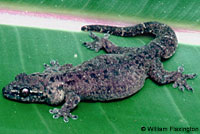 © William Flaxington © William Flaxington |
||||||
| Sceloporus cyanogenis - Blue Spiny Lizard | |||||||
| (= Sceloporus serrifer) According to Robert Stebbins in California Amphibians and Reptiles, 1972, this species, native to southern Texas and northeastern Mexico, could be found at the base of the Palms to Pines Highway above Palm Springs. Whether or not it was established and breeding was unknown. It does not appear that they remain in the area. Wikipedia |
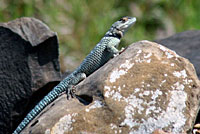 |
||||||
| Non-Native Turtles No Longer Established in California | |||||||
| Gopherus berlandieri - Texas Tortoise | |||||||
| According to Robert Stebbins in California Amphibians and Reptiles, 1972, this species, native to southern Texas and northeastern Mexico, could be found occasionally in the desert where it was released as an unwanted pet. Whether it became established anywhere was then unknown, but it is doubtful now that they are established anywhere in the state. Wikipedia |
 |
||||||
| Malaclemys terrapin - Diamondback Terrapin | |||||||
| Attempts were made to establish Diamondback Terrapins in the San Francisco Bay, but they did not succeed. See my notes above. |
 © 2011 Todd Pierson |
||||||
Return to the Top
© 2000 -